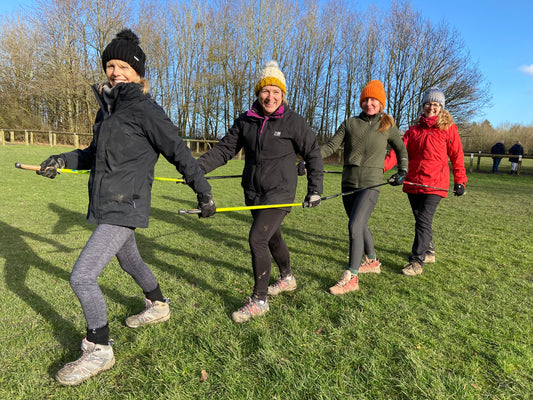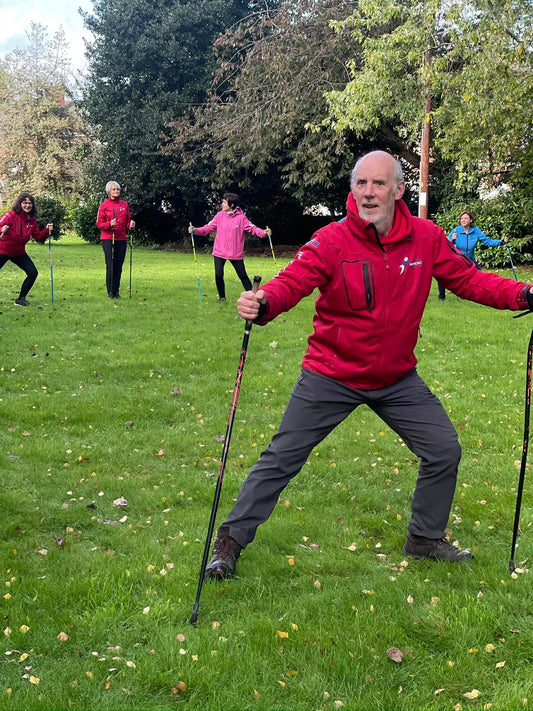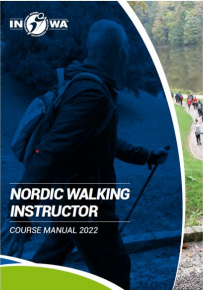Kit Advice
British Nordic Walking is an independent organisation, and as such our kit advice is not brand specific. We hope this section will give you all the information you need to shop wisely for your Nordic Walking poles & kit.
Nordic Walking Poles
Nordic Walking poles are very different from trekking or walking poles. On the most part Nordic Walking poles are a much lighter weight and have a specialist strap as opposed to just a looped strap. Often Nordic Walking poles have an ergonomically shaped handle, and are left and right hand specific. A removable shaped rubber ‘paw’ covers the tungsten carbide tip of the pole to facilitate walking on hard surfaces such as pavements. A good quality pole will have an element of carbon in their composition. The carbon content of the pole affects weight, the power transfer and the shock absorbency. Look for a carbon content of at least 40%.
The following are some of the questions often asked about poles:
Should I buy a fixed length or adjustable pole?
We recommend that most people consider buying a fixed length pole. Nordic Walking poles should be as light as possible and the mechanism used to make a pole adjustable increases the swing weight of the pole. Making the pole adjustable also significantly weakens the pole and so if you want to practice sport techniques, or if you’re a big guy, they are not a good idea. Even for general Nordic Walking an adjustable pole will transfer less power from the push off than a fixed length pole.
A common myth is that you need to adjust the pole length according to if you are walking up or downhill. This is not true for Nordic Walking. Pole length is set to an individual’s height and we adjust our technique rather than the pole for different terrains.
What length pole do I need?
A good guide to pole length is to take your height in cms and multiply it by 0.68, then round down to the nearest 5 cms. When you stand with your upper arm at your side your elbow should form a 90° angle or slightly more, so your hand is just below your elbow. There are some exceptions to this rule and so it's always a good idea to have a lesson from an INWA instructor before buying poles so they can advise you.
How long will my poles last?
Any good quality pole should last you a good long time but there are parts that will wear. The rubber paws, for walking on tarmac, wear out like a car tyre, and are easy to lose from your pocket! They are pretty cheap to replace, around £8 a pair. The tungsten carbide tip of the pole may wear if you walk on gravel or stony surfaces a lot; this again is replaceable on most poles. You can usually also buy replacement straps.
How much will they cost?
A quality Nordic Walking pole will cost anything from £60 to £135 for a pair. Much cheaper poles are available and can be a great way to get started. Cheaper poles are often not heat treated in manufacture and so lack strength and may shatter. The main thing is to buy what you can afford and to get out there and enjoy Nordic Walking.
Where can I buy poles?
Click on one of the links to the left or speak to a local instructor to find your nearest stockist of Nordic Walking poles and kit. Barefoot Studio's webshop (www.barefootstudiostore.co.uk) sells a good range of both Leki and Exel Nordic walking poles as well as clothing, shoes and accessories for Nordic walking. You can also buy Nordic Walking poles from Exel by visiting their website www.exelpoles.co.uk.
Footwear & clothing
You don’t need specialist footwear & clothing for Nordic Walking but there is some great kit out there that will keep you comfortable and dry.
We recommend you Nordic Walk in shoes rather than boots and a waterproof breathable Nordic Walking shoe is ideal. Layered clothing will allow you to adjust to the weather without restricting movement. Breathable fabrics are great and an outer waterproof shell is a must, unless you are a fine weather walker.
Nordic Walking Poles
Nordic Walking poles are very different from trekking or walking poles. On the most part Nordic Walking poles are a much lighter weight and have a specialist strap as opposed to just a looped strap. Often Nordic Walking poles have an ergonomically shaped handle, and are left and right hand specific. A removable shaped rubber ‘paw’ covers the tungsten carbide tip of the pole to facilitate walking on hard surfaces such as pavements. A good quality pole will have an element of carbon in their composition. The carbon content of the pole affects weight, the power transfer and the shock absorbency. Look for a carbon content of at least 40%.
The following are some of the questions often asked about poles:
Should I buy a fixed length or adjustable pole?
We recommend that most people consider buying a fixed length pole. Nordic Walking poles should be as light as possible and the mechanism used to make a pole adjustable increases the swing weight of the pole. Making the pole adjustable also significantly weakens the pole and so if you want to practice sport techniques, or if you’re a big guy, they are not a good idea. Even for general Nordic Walking an adjustable pole will transfer less power from the push off than a fixed length pole.
A common myth is that you need to adjust the pole length according to if you are walking up or downhill. This is not true for Nordic Walking. Pole length is set to an individual’s height and we adjust our technique rather than the pole for different terrains.
What length pole do I need?
A good guide to pole length is to take your height in cms and multiply it by 0.68, then round down to the nearest 5 cms. When you stand with your upper arm at your side your elbow should form a 90° angle or slightly more, so your hand is just below your elbow. There are some exceptions to this rule and so it's always a good idea to have a lesson from an INWA instructor before buying poles so they can advise you.
How long will my poles last?
Any good quality pole should last you a good long time but there are parts that will wear. The rubber paws, for walking on tarmac, wear out like a car tyre, and are easy to lose from your pocket! They are pretty cheap to replace, around £8 a pair. The tungsten carbide tip of the pole may wear if you walk on gravel or stony surfaces a lot; this again is replaceable on most poles. You can usually also buy replacement straps.
How much will they cost?
A quality Nordic Walking pole will cost anything from £60 to £135 for a pair. Much cheaper poles are available and can be a great way to get started. Cheaper poles are often not heat treated in manufacture and so lack strength and may shatter. The main thing is to buy what you can afford and to get out there and enjoy Nordic Walking.
Where can I buy poles?
Click on one of the links to the left or speak to a local instructor to find your nearest stockist of Nordic Walking poles and kit. Barefoot Studio's webshop (www.barefootstudiostore.co.uk) sells a good range of both Leki and Exel Nordic walking poles as well as clothing, shoes and accessories for Nordic walking. You can also buy Nordic Walking poles from Exel by visiting their website www.exelpoles.co.uk.
Footwear & clothing
You don’t need specialist footwear & clothing for Nordic Walking but there is some great kit out there that will keep you comfortable and dry.
We recommend you Nordic Walk in shoes rather than boots and a waterproof breathable Nordic Walking shoe is ideal. Layered clothing will allow you to adjust to the weather without restricting movement. Breathable fabrics are great and an outer waterproof shell is a must, unless you are a fine weather walker.
Our courses
-
INWA Nordic Walking Instructor Course
Regular price £485.00Regular priceUnit price / per -
Walk Leader Course
Regular price £140.00Regular priceUnit price / per£140.00Sale price £140.00 -
INWA manual
Regular price £35.00Regular priceUnit price / per




